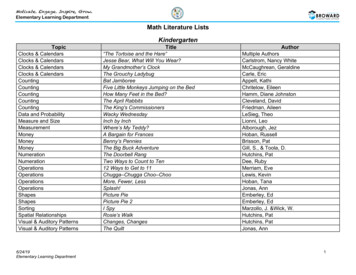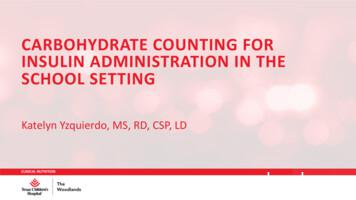Teaching Counting - Intensive Intervention
Teaching Counting:Considerations for InstructionPurpose and Overview of GuideThe purpose of this guide is to provide strategies and materials for developing andimplementing lessons for students who need intensive instruction in the area of place value,numeracy, and counting. Resource room teachers, math interventionists, and others workingwith struggling students may find this guide helpful.Within college- and career-ready standards, place value, numeracy, and counting aretaught in Grades 1 and 2. This guide may be used as these concepts are introduced, orwith students in higher grade levels who continue to struggle with the concepts.The guide is divided into four sections:1. Sequence of skills as defined by college- and career-ready standards2. A list of important vocabulary and symbols3. A brief explanation of the difficulties students may have with counting4. Suggested activities and strategies for teaching counting conceptsSequence of Skills—College- and Career-ReadyStandards(The grade level of a standard is represented by the number or letter in parentheses.)Know number names and the count sequence.¡¡ Count to 100 by ones and by tens. (K)¡¡ Count forward beginning from a given number. (K)¡¡ Write numbers from 0 to 20. (K)¡¡ Represent a number of objects with a written numeral 0–20. (K)Count to tell the number of objects.¡¡ Understand the relationship between numbers and quantities. (K)Teaching Counting: Considerations for Instruction
¡¡ Connect counting to cardinality. (K)¡¡ When counting objects, do the following: Say the number names in the standard order. (K) Pair each object with one and only one number name, and each number name withone and only one object. (K) Understand that the last number name said tells the number of objects counted. (K) Understand that the number of objects is the same regardless of their arrangementor the order in which they were counted. (K) Understand that each successive number name refers to a quantity that is one larger. (K)¡¡ Count to answer “How many?” questions about as many as 20 things arranged in a line,a rectangular array, or a circle, or as many as 10 things in a scattered configuration. (K)¡¡ Given a number from 1–20, count out that many objects. (K)Compare numbers.¡¡ Identify whether the number of objects in one group is greater than, less than, or equalto the number of objects in another group. (K)¡¡ Compare two numbers between 1 and 10 presented as written numerals. (K)Extend the counting sequence.¡¡ Count to 120, starting at any number. (1)¡¡ Read and write numerals (to 12), and represent a number of objects with awritten numeral. (1)¡¡ Count within 1,000. (2)¡¡ Skip count by 5s, 10s, and 100s. (2)Add and subtract within 20.¡¡ Relate counting to addition and subtraction. (1)2Teaching Counting: Considerations for Instruction
Vocabulary and SymbolsThe following terms are important for students to understand when working with counting.Number:An object used to count.0, 1, 2, 3, 4, 5, 6, 7, 8, 9, 10Numeral:A symbol used to describea number.Counting:Finding the amount of a set.357Cardinal number:The amount of a set.1, 2, 3 objects:3 is the cardinal number.Odd:A number not divided evenlyby 2.Ordinal number:A word that shows the order ina set.Even:A number divided evenly by 2.0, 2, 4, 6, 8, 10thirdfifty-seventhQuantity:The amount of a set.More:A word describing a set thatis larger.1, 3, 5, 7, 9Less:A word describing a set thatis smaller.Equal:Two sets have the same amount.Common Areas of Difficulty¡¡ Counting principles¡¡ Understanding of numbers and what numbers representFive Counting Principles¡¡ One-to-one correspondence. When counting, students assign one (and only one)count to each object of a set. Partitioning and tagging helps with this skill. Partition. Touch or move one object. Tag. Assign a number to that one object.¡¡ Stable order. The order in which students count is stable. In English, we start with 1and count forward: 1, 2, 3, 4, 5, 6, 7, 8, 9, 10. The counting order never changes.¡¡ Cardinality. When counting objects in a set, the last count represents the numberof objects in the set. For example, if 5 objects are on the table, the student counts,“1, 2, 3, 4, 5.” When asked how many objects, the student answers, “5.”Teaching Counting: Considerations for Instruction3
¡¡ Abstraction. Counting can be used to count any collection of objects. It does notmatter whether all the objects in the set are the same. “Objects” can also be claps,sounds, or imaginary objects.¡¡ Order-irrelevance. The way objects are counted (e.g., left to right, top to bottom) does notmatter when counting. The counting order does not change the cardinality of the set.Conceptual UnderstandingManipulatives can be used to help practice counting skills. Some examples of countingmanipulatives include Unifix cubes, clips, toy animals, chips, and candies.Activities and Strategies Related toSpecific StandardsKnow number names and the count sequence.¡¡ Teach and sing counting songs. A variety of songs are available on YouTube athttp://www.youtube.com/. Don’t always stop counting at 10. Continue counting to 20. When counting, show the written numbers that accompany the number word.¡¡ Teach skip counting through chants or songs. Practice counting with number lines or hundreds charts.4Teaching Counting: Considerations for Instruction
¡¡ Give a number (e.g., 6) and count on. Start with 6 and count up to 15. Ready? 6, 7, 8, 9, 10, 11, 12, 13, 14, 15.¡¡ Present story problems that require counting on. Devin had 5 apples in his basket and then he picked some more. Let’s start at 5and count more apples.¡¡ Write numbers. Practice motions of writing numbers in rice, pudding, glitter, sand, or dirt. Teach appropriate pencil hold. Practice writing numbers on paper. Learn rhymes for writing numbers.Number Writing RyhmesNumber 1 is like a stick, a straight line down that’s very quick.For number 2 go right around, then make a line across the ground.Go right around, what will it be? Go round again to make a 3.Down and over and down some more, that’s the way to make a 4.Go down and around, then you stop, finish the 5 with a line on top.Make a curve, then a loop, there are no tricks to making a 6.Across the sky and down from heaven, that’s the way to make a 7.Make an “S” and then don’t wait, go up again to make an 8.Make a loop and then a line, that’s the way to make a 9.¡¡ Show a set of objects and write the number.Count to tell the number of objects.¡¡ Show a set of objects and count. Partition and tag items as they are counted.At the end of counting, say the total number of objects in the set.¡¡ For example:Teaching Counting: Considerations for Instruction5
There are one (touch the blue dino), two (touch the yellow dino), three (touch thelime green dino), four (touch the dark green dino), five (touch the orange dino).There are five dinosaurs. I can count these in a different way. There are one (touch the dark green dino), two(touch the yellow dino), three (touch the orange dino), four (touch the lime greendino), five (touch the blue dino). There are still five dinosaurs.¡¡ Show a set of objects and answer the question, “How many?” For example: Place nine chips in a line and ask, “How many?” Place nine chips in a rectangle shape and ask, “How many?” Place nine scattered chips and ask, “How many?”¡¡ Say a number and show that many objects. For example: Show me 13 cubes.Compare numbers.¡¡ Show two sets of objects and ask: “Which set has more?” “Which set has less?”“Are the sets the same or equal?”¡¡ Show two written numerals and ask: “Which is more?” “Which is less?” “Are thenumbers the same or equal?” At first, choose numbers with a greater difference in magnitude (e.g., 2 and 9,3 and 8). Then, choose numbers closer in magnitude (e.g., 3 and 5, 7 and 8). Once place value is introduced, choose numbers that are often confusing(e.g., 17 and 71, 23 and 32).¡¡ Teach signs with the Greater Gator.6Teaching Counting: Considerations for Instruction
Extend the counting sequence.¡¡ Teach counting to 120, starting at any number. Use number lines or hundreds charts.¡¡ Teach counting to 1,000, starting at any number.¡¡ Reinforce skip counting skills. Flash one hand (i.e., five fingers) when counting by fives. Flash two hands when counting by tens.Add and subtract within 20.¡¡ Start with a number and count on. Start with 4 and count up 2 more. Ready? 4, 5, 6. 4 plus 2 is 6. It may be helpful to teach showing the number counted on with fingers:3777b 01/15 Put the 4 in your head. Now, we count on 2. Ready? 5 (hold up 1 finger), 6(hold up 2 fingers). 4 plus 2 is 6.Teaching Counting: Considerations for Instruction7
numeracy, and counting. Resource room teachers, math interventionists, and others working with struggling students may find this guide helpful. Within college- and career-ready standards, place value, numeracy, and counting
Addition Anno’s Counting House Anno, Mitsumasa Climate Cactus Desert, Arctic Tundra Silver, Donald Climate Tropical Rain Forest Silver, Donald Counting 26 Letters and 99 Cents Hoban, Tana Counting Anno’s Counting Book Anno, Mitsumasa Counting Let’s Count Tana Hoban Counting The Great Pe
Step 1- Counting nickels and dimes by 5 and 10 and counting quarters (25, 50, 75, 100) Step 2- Counting dimes and nickels (start with the dimes) Step 3- Counting dimes and pennies and nickels and pennies Step 4- Counting on from quarters (25/75) with nickels and dimes Coin Cards (Use
mass m extensive kg molar mass M intensive kg mol-1 temperature T intensive K pressure P, p intensive Pa fugacity f intensive Pa density intensive kg m-3 volume V extensive m3 molar volume V m, v, intensive m3 mol-1 heat Q extensive J work W extensive J inner energy U extensive J enthalpy H extensi
hired or self-employed. (c) Intensive SEMP may be provided as: (1) Intensive - 1, which is Intensive SEMP provided to one individual; or (2) Intensive - 2, which is Intensive SEMP provided to a group of 2-8 individuals. (d) Intensive SEMP can only be provided for a time-limited period
Chapter 2 Skip-Counting Skip-Counting 3.OA.D.9,2.OA.C.4 Gu i d e : 3A pg. 44-49 (R&G) Prac t i c e : 3A pg. 39 (#1-5) O nl i ne : Skip-Counting Basics Skip-Counting Objects 3.OA.D.9,2.OA.C.4 Prac t i c e : 3A pg. 40-44 (#6-28) O nl i ne : Counting Critters, Gumball Art Hundred Char ts 1 3.OA.D.9 Gu i d e : 3A pg. 50-55 (Ms. Q) Prac t i c e : 3A .
CLINICAL NUTRITION Studies show that people with better carb counting skills have better BG control. Counting carbs is the best way of keeping blood sugars under control- better than limiting sugars, counting calories or using an exchange system. Inaccurate carb counting can lead tolow blood sugars or
numbers from 0 to 20. In Grade 1 children understand counting as a thinking strategy. They relate counting on to addition and subtraction and counting back to subtraction. They relate the counting sequence to the cardinality of numbers: each number is one more or one less than the number after or before. Children read and
Alfredo Chavero (1981) concluye que los anteojos no son otra cosa que ex-presiones de las nubes y en cuanto a los colmillos, . lo señala Alfredo López Austin (1990): .como creador, Tláloc lo fue de la luna, del agua y de la lluvia y fue también uno de los cuatro soles cosmogónicos que precedieron al actual. Además de esto, reinaba en su propio paraí-so, el Tlalocan, que se .























